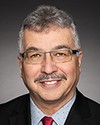I call the meeting to order.
Good morning. Welcome to meeting number 38 of the House of Commons Standing Committee on Indigenous and Northern Affairs.
As you know, we are meeting on the unceded territory of the Algonquin Anishinabe peoples.
Pursuant to the House order of reference adopted on Thursday, September 29, 2022, and pursuant to the motion adopted that same day by the committee, we are meeting to proceed with the clause-by-clause review of Bill C-29, an act to provide for the establishment of a national council for reconciliation.
Today's meeting is taking place in a hybrid format, pursuant to the House order of June 23, 2022.
I would now like to make a few comments for the benefit of all.
Please wait until I recognize you by name before speaking.
For those participating by video conference, click on the microphone icon to activate your microphone and please mute yourself when you're not speaking.
For interpretation services, those participating via Zoom have the choice, at the bottom of their screen, of either floor, English or French. Those participating in person, in the room, can select the appropriate channel and use their earpiece.
As a reminder, all comments should be addressed through the chair.
For members in the room, if you wish to speak, please raise your hand. For members on Zoom, please use the “raise hand” function. The clerk and I will do our best to manage the speaking order as best we can, and we appreciate your patience and understanding in this regard.
First of all, I'd like to welcome some witnesses who are with us this morning to help us if we have any technical questions.
From the Department of Crown-Indigenous Relations and Northern Affairs, we have Mr. Andy Garrow, who is the director, policy and strategic direction, reconciliation secretariat, planning and partnerships. We also have Kate Ledgerwood, director general, policy and strategic direction, reconciliation secretariat.
As well, from the Department of Justice, we have Dr. Seetal Sunga, who is a senior counsel.
I'd also like to point out that we have with us experts on the legislative process associated with clause-by-clause study, Madame Thivierge and Mr. Pagé. Don't hesitate to use the resources that we have available if there are any questions.
As we begin clause-by-clause consideration of Bill C-29, I'd like to provide members of the committee with some instructions and a few comments on how the committee will proceed.
As the name indicates, this is an examination of all the clauses in the order in which they appear in the bill. I will call each clause successively, and each clause is subject to debate and a vote. If there are amendments to the clause in question, I will recognize the member proposing the amendment, who may explain it. The amendment will then be open for debate. When no further members wish to intervene, the amendment will be voted on.
Amendments will be considered in the order in which they appear in the bill or in the package each member received from the clerk.
Members should note that new amendments or subamendments must be submitted in writing to the clerk of the committee.
We may have to pause briefly if some amendments or subamendments are introduced today.
The chair will go slowly. This is not a speed trial. We are going to go as slowly as we need to get this right. I will admit that this is my first time going through a bill.
Amendments have been given an alphanumeric number in the top right corner to indicate which party submitted the amendment. There is no need for a seconder to move an amendment. Once it is moved, you will need unanimous consent to withdraw it.
When an amendment is being debated, members may propose subamendments, which must be submitted in writing. The permission of the mover of the amendment is not required. The committee can have only one subamendment before it at a time, and that subamendment cannot be amended. When a subamendment is moved, it is voted on first. Then, another subamendment may be moved, or the committee may consider the main amendment and vote on it.
Once all the clauses have been put to a vote, the committee will vote on the short title of the bill—in other words, clause 1—the preamble, the long title and the bill as a whole. If amendments are adopted, it will be necessary to order a reprint of the bill as a working copy for House use at report stage. Lastly, the committee shall direct the chair to report the bill to the House. The report will indicate only the amendments that were made and any clauses that were removed.
Now we will begin the process.
Pursuant to Standing Order 75(1), consideration of clause 1, which is the short title, and of the preamble are postponed until the end.
I will now call clause 2.
In some cases no amendments have been proposed. I will ask whether the clause shall carry.
On the first one, I'm going to ask for a recorded vote just to get us into the rhythm of this process. I won't do that for every clause when there's unanimous consent.
When we do get to the amendments, if it is you who are proposing the amendment, you will be asked to move it; then, if you wish to explain it, you will have a chance to explain it. Then we go to debate. I hope that's fairly clear.
Is that clear, Mr. Vidal?




